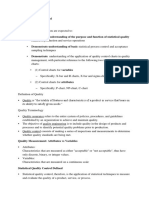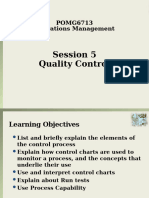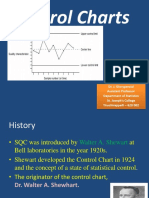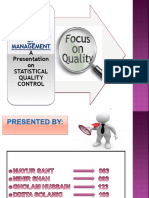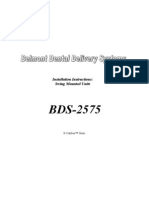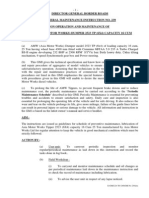Control Charts For A-Ributes: Hometown Bank
Control Charts For A-Ributes: Hometown Bank
Uploaded by
Aanchal ChadhaCopyright:
Available Formats
Control Charts For A-Ributes: Hometown Bank
Control Charts For A-Ributes: Hometown Bank
Uploaded by
Aanchal ChadhaOriginal Description:
Original Title
Copyright
Available Formats
Share this document
Did you find this document useful?
Is this content inappropriate?
Copyright:
Available Formats
Control Charts For A-Ributes: Hometown Bank
Control Charts For A-Ributes: Hometown Bank
Uploaded by
Aanchal ChadhaCopyright:
Available Formats
9/21/16
Hometown Bank
Control Charts
for A-ributes
Example
p-chart: A chart used for controlling the
propor7on of defec7ve services or
products generated by the process.
p =
The operations manager of the booking services department of Hometown Bank
is concerned about the number of wrong customer account numbers recorded by
Hometown personnel.
Each week a random sample of 2,500 deposits is taken, and the number of
incorrect account numbers is recorded. The results for the past 12 weeks are
shown in the following table.
p(1 p)/n
Where
n = sample size
p = central line on the chart, which can be either the historical
average population proportion defective or a target value.
Control limits are: UCLp = p+zp and LCLp = pzp
z = normal deviate (number of standard deviations from the average)
Is the booking process out of statistical control? Use three-sigma control limits.
Hometown Bank
Hometown Bank
Using a p-Chart to monitor a process
Using a p-Chart to monitor a process
n = 2500
p=
p =
p =
147
= 0.0049
12(2500)
p(1 p)/n
0.0049(1 0.0049)/2500
p = 0.0014
UCLp = 0.0049 + 3(0.0014)
= 0.0091
LCLp = 0.0049 3(0.0014)
= 0.0007
Sample
Number
Wrong
Account #
Proportion
Defective
1
2
3
4
5
6
7
8
9
10
11
12
15
12
19
2
19
4
24
7
10
17
15
3
0.006
0.0048
0.0076
0.0008
0.0076
0.0016
0.0096
0.0028
0.004
0.0068
0.006
0.0012
Total
147
In class Problem
Example
Control Charts
Two types of error are possible with control
charts
A type I error occurs when a process is
thought to be out of control when in fact
it is not
A type II error occurs when a process is
thought to be in control when it is
actually out of sta7s7cal control
These errors can be controlled by the
choice of control limits
9/21/16
Process Capability
Process Capability
Process capability is the ability of the
process to meet the design specica7ons
for a service or product.
Nominal value is a target for design
specica7ons.
Tolerance is an allowance above or below
the nominal value.
Nominal
value
Process distribution
Lower
specification
20
Upper
specification
25
30
Process is capable
Process Capability
Process Capability Ra7o, Cp
Process capability ra7o, Cp, is the tolerance width divided by 6 standard
devia7ons (process variability).
Nominal
value
Process distribution
Lower
specification
20
Upper
specification
25
Cp =
Upper specification - Lower specification
6
30
Process is not capable
Intensive Care Lab
Process Capability Index, Cpk
Example
Process Capability Index, Cpk, is an index that measures the poten7al
for a process to generate defec7ve outputs rela7ve to either upper
or lower specica7ons.
Cpk = Minimum of
=
x Lower specica7on
3
Upper specica7on x=
3
We take the minimum of the two ra7os because it gives the worstcase situa7on.
The intensive care unit lab process has an average turnaround 7me
of 26.2 minutes and a standard devia7on of 1.35 minutes.
The nominal value for this service is 25 minutes with an upper
specica7on limit of 30 minutes and a lower specica7on limit of 20
minutes.
The administrator of the lab wants to have three-sigma performance
for her lab. Is the lab process capable of this level of performance?
Upper specification = 30 minutes
Lower specification = 20 minutes
Average service = 26.2 minutes
= 1.35 minutes
9/21/16
Intensive Care Lab
Intensive Care Lab
Assessing Process Capability
Example
Example
Upper specica7on = 30 minutes
Lower specica7on = 20 minutes
Average service = 26.2 minutes
= 1.35 minutes
=
x Lower specica7on
Cpk = Minimum of
Assessing Process Capability
Cpk =
Minimum of
Cpk =
Minimum of
26.2 20.0
3(1.35)
1.53, 0.94
Cp =
Upper specica7on x
Cp =
30.0 26.2
3(1.35)
= 0.94
Process
Capability
Index
In Class Problem
What it means to operate at 6-sigma
Nominal value
Six sigma
Four sigma
Two sigma
Lower
specification
Upper
specification
= 1.23 Process Capability Ra7o
Before Process Modification
Upper specification = 30.0 minutes Lower specification = 20.0 minutes
Average service = 26.2 minutes
= 1.35 minutes Cpk = 0.94 Cp = 1.23
In Class Problem
Eects of Reducing
Variability on Process Capability
30 - 20
6(1.35)
Does not meet 3 (1.00 Cpk) target due to a shift in mean
(Note variability is ok since Cp is over 1.0)
Upper specica7on - Lower specica7on
6
Range
Popula7on in range
Expected frequency outside
range
Approx. frequency for daily
event
0.682689492137
1 in 3
Twice a week
0.954499736104
1 in 22
Every three weeks
0.997300203937
1 in 370
Yearly
0.999936657516
1 in 15,787
Every 43 years (twice in a
life7me)
0.999999426697
1 in 1,744,278
Every 5,000 years (once in
history)
0.999999998027
1 in 506,842,372
Every 1.5 million years
Mean
9/21/16
Six Sigma
3.4 defects per million
Cpk = 2
Impact of number of parts or produc7on steps
on yield:
6 sigma
1 100%
5 100%
10 100%
100 99.97%
4 sigma
3 sigma
99%
97%
94%
54%
99%
71%
50%
0%
Designing in 6-sigma
Reduce the number of parts in a product
Reduce the number of steps in a process
Six Sigma
Improvement Model
Six Sigma
Six Sigma is a comprehensive and exible system for
achieving, sustaining, and maximizing business success
by minimizing defects and variability in processes.
It relies heavily on the principles and tools of TQM.
It is driven by a close understanding of customer needs;
the disciplined use of facts, data, and sta7s7cal analysis;
and diligent a-en7on to managing, improving, and
reinven7ng business processes.
1. Dene Determine the current process
characteris7cs cri7cal to customer sa7sfac7on
and iden7fy any gaps.
2. Measure Quan7fy the work the process does
that aects the gap.
3. Analyze Use data on measures to perform
process analysis.
4. Improve Modify or redesign exis7ng methods to
meet the new performance objec7ves.
5. Control Monitor the process to make sure high
performance levels are maintained.
Six Sigma
Implementa7on
Top Down Commitment from corporate leaders.
Measurement Systems to Track Progress
Tough Goal Sejng through benchmarking bestin-class companies.
Educa7on: Employees must be trained in the
whys and how-tos of quality.
Communica7on: Successes are as important to
understanding as failures.
Customer Priori7es: Never lose sight of the
customers priori7es.
Six Sigma Educa7on
Green Belt: An employee who achieved the rst level of
training in a Six Sigma program and spends part of his
or her 7me teaching and helping teams with their
projects.
Black Belt: An employee who reached the highest level
of training in a Six Sigma program and spends all of his
or her 7me teaching and leading teams involved in Six
Sigma projects.
Master Black Belt: Full-7me teachers and mentors to
several black belts.
9/21/16
International Quality
Documentation Standards
ISO
9000
ISO
14000
Malcolm Baldrige Na7onal Quality
Award
Named ater the late secretary of commerce, a strong proponent of
enhancing quality as a means of reducing the trade decit. The
award promotes, recognizes, and publicizes quality strategies and
achievements.
A set of standards governing documenta7on
of a quality program.
1.
2.
3.
4.
Documenta7on standards that require par7cipa7ng
companies to keep track of their raw materials use
and their genera7on, treatment, and disposal of
hazardous wastes.
Category 1 Leadership
120 points
Category 2 Strategic Planning
85 points
Category 3 Customer and Market Focus
85 points
Category 4 Measurement, Analysis, and
Knowledge Management
90 points
5. Category 5 Human Resource Focus
6. Category 6 Process Management
7. Category 7 Business Results
85 points
85 points
450 points
You might also like
- ch07 PDFDocument85 pagesch07 PDFNadya Azzan100% (2)
- EASA Form 1 For MergeDocument4 pagesEASA Form 1 For MergephongVAECONo ratings yet
- Statistical Process ControlDocument43 pagesStatistical Process Controlninasway100% (2)
- Getinge Wd15 Claro Washer Disinfector: Configuration SheetDocument8 pagesGetinge Wd15 Claro Washer Disinfector: Configuration SheetNimsi AstiviaNo ratings yet
- 2002 Stratus SebringDocument523 pages2002 Stratus SebringNormand FréchetteNo ratings yet
- Quality Control Project: DataDocument13 pagesQuality Control Project: DataWaqar DarNo ratings yet
- Statistical Process ControlDocument66 pagesStatistical Process Controlanshuldce50% (2)
- Control Charts - MBADocument30 pagesControl Charts - MBAShivangi Dhamija100% (1)
- Lect 6 - Process CapabilityDocument26 pagesLect 6 - Process CapabilityBurcu Gözde Bilol100% (1)
- Unit 6 Control Charts For Attribute Data: STAT8010 Applied Statistical TechniquesDocument29 pagesUnit 6 Control Charts For Attribute Data: STAT8010 Applied Statistical TechniquesIsha BNo ratings yet
- L5_L6_SPCDocument62 pagesL5_L6_SPCchaitanyaNo ratings yet
- Statistical Quality Control (SQC) FinalDocument47 pagesStatistical Quality Control (SQC) FinalSagar DhageNo ratings yet
- Quality ControlDocument13 pagesQuality ControlEuniceChungNo ratings yet
- SPCDocument59 pagesSPCadibhai06100% (2)
- Process Capability and SPC : Operations ManagementDocument43 pagesProcess Capability and SPC : Operations ManagementRahul KhannaNo ratings yet
- Control ChartsDocument36 pagesControl ChartsGulshan KandaNo ratings yet
- Technical Note 8: Process Capability and Statistical Quality ControlDocument46 pagesTechnical Note 8: Process Capability and Statistical Quality ControlVipin NairNo ratings yet
- SQC MATH. (Vikas, Vaibhav, Swanand, ShreeDocument39 pagesSQC MATH. (Vikas, Vaibhav, Swanand, ShreeVikasPatilNo ratings yet
- Statistical Quality ControlDocument3 pagesStatistical Quality ControlHunson Abadeer100% (1)
- Quality ManagementDocument10 pagesQuality ManagementTifarie Luesas50% (4)
- Statistical Quality Control: by 4Th Edition © Wiley 2010 Powerpoint Presentation by R.B. Clough - Unh M. E. Henrie - UaaDocument40 pagesStatistical Quality Control: by 4Th Edition © Wiley 2010 Powerpoint Presentation by R.B. Clough - Unh M. E. Henrie - UaaInderpreet SinghNo ratings yet
- Statistical Process ControlDocument42 pagesStatistical Process ControlErick Bok Cang YeongNo ratings yet
- Control Charts For Attributes: MGT 6421 Quality Management IIDocument12 pagesControl Charts For Attributes: MGT 6421 Quality Management IIRoque EstradaNo ratings yet
- Control ChartsDocument36 pagesControl ChartsEr Vaibhav NyatiNo ratings yet
- Control ChartsDocument36 pagesControl ChartsArpit AgarwalNo ratings yet
- Operation ManagementDocument66 pagesOperation ManagementsemerederibeNo ratings yet
- Statistical Quality ControlDocument13 pagesStatistical Quality ControlsekelanilunguNo ratings yet
- Statistics For Business and Economics: Bab 20Document43 pagesStatistics For Business and Economics: Bab 20balo100% (1)
- Chap 04Document9 pagesChap 04gttomcatNo ratings yet
- As 6 Control Charts For AttributesDocument32 pagesAs 6 Control Charts For AttributesRoque Estrada100% (1)
- Ch.4 - Control Charts For AttributesDocument34 pagesCh.4 - Control Charts For AttributesAbdullah Hazeem100% (3)
- SPC: Statistical Process ControlDocument53 pagesSPC: Statistical Process ControlSaoloan NaiborhuNo ratings yet
- SPCDocument62 pagesSPCSagar KansalNo ratings yet
- Statistical Process Control (SPC)Document36 pagesStatistical Process Control (SPC)SYEDOUNMUHAMMAD ZAIDI100% (1)
- TQM Unit 3Document26 pagesTQM Unit 3Anurag KushwahaNo ratings yet
- Overview of Statistical Quality ControlDocument24 pagesOverview of Statistical Quality ControlJayalal WettasingheNo ratings yet
- Six Sigma Tactic Control 수정본Document47 pagesSix Sigma Tactic Control 수정본sumidjonova1No ratings yet
- Control ChartsDocument36 pagesControl ChartsYusranNo ratings yet
- Q8 IM13EFinalDocument44 pagesQ8 IM13EFinalJb Macaroco100% (1)
- Statistic ProcessDocument39 pagesStatistic ProcessxredjokerxNo ratings yet
- Statistical Quality Control (S.Q.C.) Presented By-: Nikhil Garg ROLL NO-0129626Document38 pagesStatistical Quality Control (S.Q.C.) Presented By-: Nikhil Garg ROLL NO-0129626jolaakNo ratings yet
- Control Charts For Attributes 2Document42 pagesControl Charts For Attributes 2وسام توفيقNo ratings yet
- Statistical Quality ControlDocument82 pagesStatistical Quality ControlShahmirBalochNo ratings yet
- Statistical Quality Control PDFDocument82 pagesStatistical Quality Control PDFInshal KhanNo ratings yet
- Total Quality Management, Statistical Process ControlDocument11 pagesTotal Quality Management, Statistical Process ControlElmer GatchalianNo ratings yet
- IENG 486 Lecture 17Document38 pagesIENG 486 Lecture 17Matías IgnacioNo ratings yet
- Control Chart BasicsDocument36 pagesControl Chart BasicsSalman AbuzuhairaNo ratings yet
- Control Chart BasicsDocument36 pagesControl Chart Basicstikar69314No ratings yet
- Basic Business Statistics: Statistical Applications in Quality and Productivity ManagementDocument67 pagesBasic Business Statistics: Statistical Applications in Quality and Productivity ManagementToufiq Khan MajlisNo ratings yet
- Which Control Charts To Use WhereDocument115 pagesWhich Control Charts To Use Whereanbarasuar1964No ratings yet
- POMG6713 Lecture Notes Session 5Document38 pagesPOMG6713 Lecture Notes Session 5s143472No ratings yet
- P ChartDocument21 pagesP ChartSumit Patil100% (1)
- Control Chart BasicsDocument35 pagesControl Chart BasicsPamela MorcillaNo ratings yet
- Lecture 6 - Basic Statistic Concepts, Control Chart & X-R ChartsDocument24 pagesLecture 6 - Basic Statistic Concepts, Control Chart & X-R ChartsThịnh Phùng ĐứcNo ratings yet
- Final Notes On SQCDocument12 pagesFinal Notes On SQCShashank Srivastava100% (1)
- Control Charts NotesDocument39 pagesControl Charts NotesFred Muthoka100% (1)
- Intro To SPCDocument57 pagesIntro To SPCRehan ShaikhNo ratings yet
- Control ChartDocument25 pagesControl ChartSURYAPRAKASH GNo ratings yet
- Statistical Quality ControlDocument38 pagesStatistical Quality ControlAlpesh SantNo ratings yet
- Wiley CMAexcel Learning System Exam Review 2017: Part 1, Financial Reporting, Planning, Performance, and Control (1-year access)From EverandWiley CMAexcel Learning System Exam Review 2017: Part 1, Financial Reporting, Planning, Performance, and Control (1-year access)No ratings yet
- Cult Comm Event: Lohri: Things NeededDocument3 pagesCult Comm Event: Lohri: Things NeededAanchal ChadhaNo ratings yet
- A5 VerisoftpptDocument4 pagesA5 VerisoftpptAanchal ChadhaNo ratings yet
- IIMA-Quotation For Audio System (Sub Woofer)Document2 pagesIIMA-Quotation For Audio System (Sub Woofer)Aanchal ChadhaNo ratings yet
- Objective Function 0: Min MinDocument2 pagesObjective Function 0: Min MinAanchal ChadhaNo ratings yet
- What Are The Advantages of Digital Cameras To PhotojournalismDocument7 pagesWhat Are The Advantages of Digital Cameras To PhotojournalismMargarito SalapantanNo ratings yet
- AT18250EC101203 旋转华夫炉 HT-2201 证书gauffreDocument1 pageAT18250EC101203 旋转华夫炉 HT-2201 证书gauffresamuel.thazardNo ratings yet
- Creating A Pygame WindowDocument3 pagesCreating A Pygame WindowFatah Imdul UmasugiNo ratings yet
- All TCP & UDP Protocols and PortsDocument35 pagesAll TCP & UDP Protocols and PortsMahmoud NaguibNo ratings yet
- Asnt Level IIDocument288 pagesAsnt Level IIvasunookesh100% (5)
- How To Format Your Research PaperDocument2 pagesHow To Format Your Research PaperMandeep Singh BhatiaNo ratings yet
- FSG ShipsDocument15 pagesFSG ShipsSimion LaurentiuNo ratings yet
- $R076ZVFDocument1 page$R076ZVFPRASHANT KANTENo ratings yet
- 3G Netact OptimizationDocument34 pages3G Netact OptimizationÖzgür ÖzcanNo ratings yet
- Gorenje E2704WDocument13 pagesGorenje E2704WBoban TimotijevicNo ratings yet
- Detroit 6 71 Valve Injector and Governor Adjustment ProcedureDocument2 pagesDetroit 6 71 Valve Injector and Governor Adjustment ProcedureBrendon HeyNo ratings yet
- 13 - GEST 87 133 Edition 6 - Overpressure Relief of Chlorine InstallationsDocument15 pages13 - GEST 87 133 Edition 6 - Overpressure Relief of Chlorine InstallationsAdemilson JuniorNo ratings yet
- PDF DocumentDocument18 pagesPDF DocumentAhahah HahahahNo ratings yet
- BDS 2575 ManualDocument16 pagesBDS 2575 Manualgabriel2378No ratings yet
- ARRI High Definition Video Assist HD-IVS - BrochureDocument12 pagesARRI High Definition Video Assist HD-IVS - BrochuretatacineNo ratings yet
- Magelis GTU - HMIG5UDocument3 pagesMagelis GTU - HMIG5UJnt MFNo ratings yet
- Manual Placa Base ASUS p6x58dDocument126 pagesManual Placa Base ASUS p6x58dAitor Carrión AmorinNo ratings yet
- 4 SMDocument49 pages4 SMAboanas MakhlofNo ratings yet
- Ieee 802.11Document13 pagesIeee 802.11jeffy100% (1)
- IM3240 DevelopmentKit 0208Document2 pagesIM3240 DevelopmentKit 0208Cyphe23No ratings yet
- AMWDocument14 pagesAMWSudeesh BabuNo ratings yet
- Jrc115157 OnlineDocument194 pagesJrc115157 OnlinefsghsrhrNo ratings yet
- 03 Product Brochure VelaroDocument12 pages03 Product Brochure VelaroVedniveadNo ratings yet
- 7.building Structural Safety ChecklistDocument2 pages7.building Structural Safety ChecklistPravin ManogaranNo ratings yet
- Drofus XFDesigner UserGuideDocument43 pagesDrofus XFDesigner UserGuidemtfsfernandezNo ratings yet
- El Pollo Loco: Success Through Warranty ManagementDocument2 pagesEl Pollo Loco: Success Through Warranty Managementdonelly1976No ratings yet
- ActiveXperts SMS ComponentDocument5 pagesActiveXperts SMS ComponentSimon AntoNo ratings yet


























